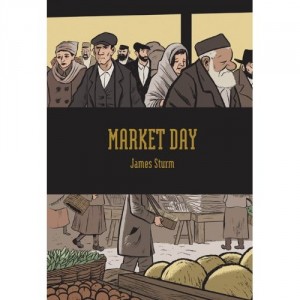James Sturm's Market Day
It is difficult to think of a more quietly influential figure in North American comic art today than James Sturm. Co-founder of the Center for Cartoon Studies in White River Junction, Vermont, also the founder of the National Association of Comics Art Educators, he is hard at work shaping the next generations of artists.
Sturm is still known best, outside comics educational circles, for the hard-won beauty of his own books, few in number (he is a painstakingly slow worker) but dauntingly detailed, plotted and drawn. The Golem’s Mighty Swing, a novelette considered one of the most influential volumes marking (along with Alison Bechdel’s Fun Home), the turn of a new century in making comic art acceptable as an art, treated a traveling Jewish baseball team of the 1920s. The teammates—including one Black slugger, their own Golem–face anti-Semitism, of course, among other, more personal conflicts and assorted woes, but the genius of the work was the care that Sturm took panel-by-panel, especially (in my view) with the human gesture.
The artist followed this volume up, several years later with James Sturm’s America: God, Gold and Golems, including a reprint of the novelette. Market Day is his first effort at pre-emigration Jewish history, and reminds us at once of Yiddish-American stories and novels about the Old World nineteenth century, seeking to recapture the sense of embattled community but also the disruption of centuries’-old lifestyles by the emergence of industrialism and urbanization. This was, after all, the era when youngsters turned secular and left the shtetl for the city, while a different kind of modernization sought to stamp out what was considered religious backwardness and Yiddish with it, failing miserably on both counts.
Market Day, Sturm’s first color book, tells us nothing by way of prose narration, not the region (but it must be Eastern Europe) nor the date (but it looks like the second half of the nineteenth century), nor even the particular market town to which the title refers. He chooses not to offer those kinds of hints at particularities, focusing instead upon the visual detail and the suggested mental world of the protagonist.
He is for sure an everyman, young husband with a pregnant wife, fretful of many things including some tragic accident to himself, bringing disaster to wife (driven to exploitation and perhaps sexual abuse by the authorities) and child. So he goes to market, on foot with his donkey and wagon behind, bearing the fruit of his labor: rugs.
Sammy Harkham, younger than Sturm and best noted as a comics editor/publisher, chooses occasionally to depict a mezuza maker in the shtetl, the prototype folk artist of the Jewish artist in our own time; surely, Sturm’s rugmaker is a similar prototype, the more so because he is an exacting artist. He believes supremely in his skill.
Strum’s everyman, the artist, also deeply enjoys the sociality of the market town, rejoicing as soon as he enters the marketplace at the abundance of fruit, vegetables, candy, boots and all kinds of goods, the variety of faces (all apparently Jewish), the rough joking of fellow tradesmen, and evident among these earthly pleasures, the dignity of the rabbis.
But times are not good. His favorite buyer has been replaced, prices are down (along with quality) and from our protagonists, no rugs are needed at all. Now everything in the market town looks grim and he spends his last coins futilely, on a fortune teller. Now, “noting is as it was before,” and he travels onward to a wholesaler, a little slice of the nearly modern world of business.
It would be unfair to the reader to go any further with this plot summary, but the artful depiction of this Jewish angst, the mixture of community and alienation, the reality that commercial life among fellow Jews can be (in this generation, at any rate) as cruel as persecution by the Gentiles and the distance between the shtetl and the market town are all seen as if never before…at least never in comic art. At 88 pages Sturm’s book may be small, but it is a masterpiece in miniature.
![[the current issue of ZEEK]](../../image/2/100/0/5/uploads/leftistethicistgraphic-52842c6a.png)
- 5000 Pages of Zeek
- Founded in 2001, Zeek was the first Jewish online magazine, and we have over 5000 pages online to prove it, all available free of charge. Read more in the Archive.
More articles by
- We're on Hiatus!
- Euphoria, Curiosity, Exile & the Ongoing Journey of a Hasidic Rebel: A Q & A with Shulem Deen
- Purim’s Power: Despite the Consequences –The Jewish Push for LGBT Rights, Part 3
- Love Sustains: How My Everyday Practices Make My Everyday Activism Possible
- Poet Q, Poet A: Jews Are Funny! Six Poets on Jewish Humor, Poetry & Activism and Survival
More articles in
Arts and Culture
- Euphoria, Curiosity, Exile & the Ongoing Journey of a Hasidic Rebel: A Q & A with Shulem Deen
- Poet Q, Poet A: Jews Are Funny! Six Poets on Jewish Humor, Poetry & Activism and Survival
- Tackling Hate Speech With Textiles: Robin Atlas in New York for Tu B’Shvat
- Fiction: Angels Out of America
- When Is an Acceptance Speech Really a Speech About Acceptance?



